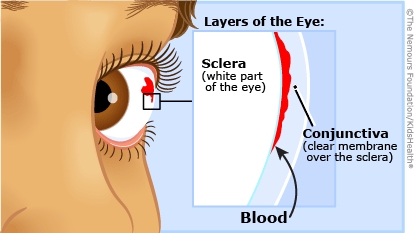Subconjunctival Hemorrhage
What Is a Subconjunctival Hemorrhage?
A subconjunctival hemorrhage (sub-con-JUNK-tih-vul HEM-er-ij) is a red spot on the white of the eye. It can look scary, but it’s usually harmless, doesn’t hurt, and won’t affect vision.
Most subconjunctival hemorrhages go away without treatment in a few days or weeks.
What Causes a Subconjunctival Hemorrhage?
The white of the eye (the sclera) is covered by the conjunctiva (kon-junk-TYE-vuh), clear tissue that has many tiny blood vessels. The blood vessels can break and leak blood when the eye is injured or someone has a quick spike in blood pressure. The blood collects between the conjunctiva and the sclera (SKLAIR-uh), leaving a bright red spot on the eye’s surface.
This can happen when someone:
- sneezes
- coughs
- throws up
- strains (for instance, when going to the bathroom)
- has high blood pressure
- takes blood-thinning medicine
- rubs the eye too hard
- wears contact lenses
- has had an eye injury
Subconjunctival hemorrhages can happen in a newborn too. They’re probably caused by pressure changes in the baby’s body during childbirth.
What Are the Signs & Symptoms of a Subconjunctival Hemorrhage?
The telltale bright red spot on the white of the eye is the only sign of a subconjunctival hemorrhage. The spot might:
- get bigger in the first 24–48 hours
- fade from red to yellow
It goes away as the body reabsorbs the leaked blood, and most are gone in 1–3 weeks.
How Is a Subconjunctival Hemorrhage Diagnosed?
Because a subconjunctival hemorrhage doesn’t hurt, many people don’t know they have one until somebody else mentions it or they look in a mirror. Doctors can tell if someone has one by looking at the eye and the spot.
How Is a Subconjunctival Hemorrhage Treated?
A subconjunctival hemorrhage doesn’t cause pain or harm to the eye. They go away on their own and don’t need medical care.
But call your doctor if your child:
- has what looks like a subconjunctival hemorrhage along with eye pain
- gets subconjunctival hemorrhages often

